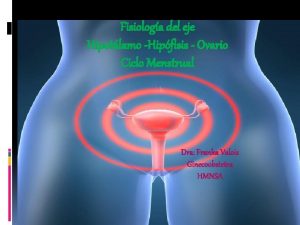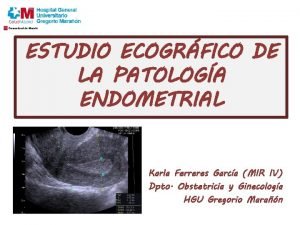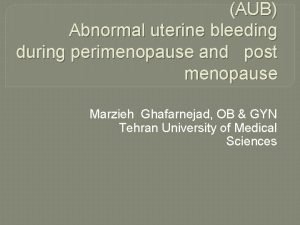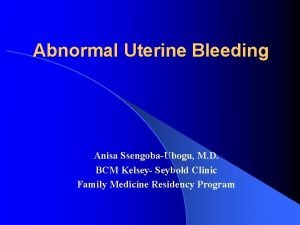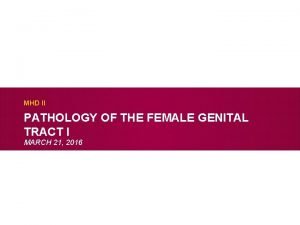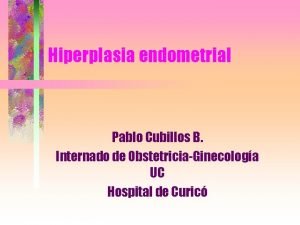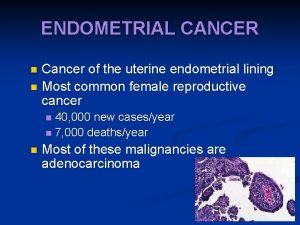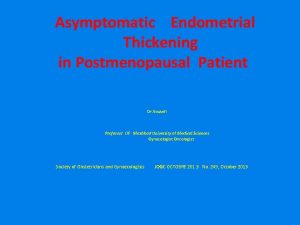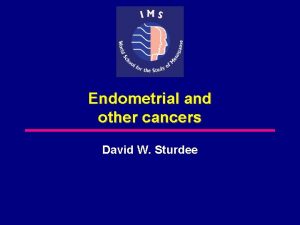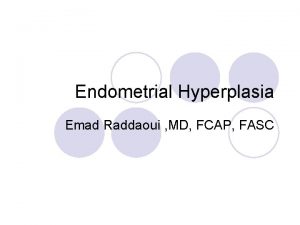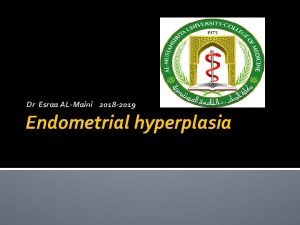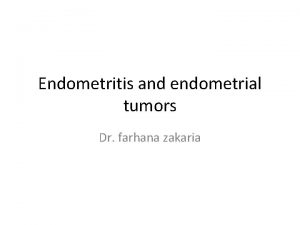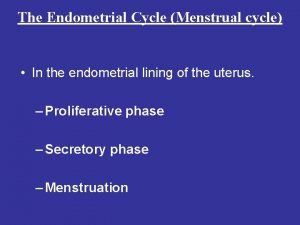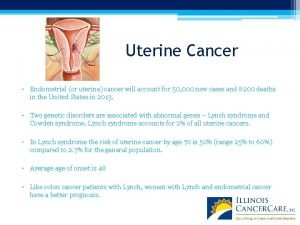Management of Endometrial Cancer dr Zohreh Yousefi Fellowship























































- Slides: 55


Management of Endometrial Cancer dr Zohreh Yousefi / Fellowship of Gynecology Oncology Ghaem Hospital, Mashhad University of Medical Sciences

In contrast to cervical cancer, patients with endometrial cancer treated with hysterectomy alone or hysterectomy and radiation do significantly better than those treated with radiation alone This appears to be related to the inability of radiation therapy effectively to eliminate disease in the myometrium

The cornerstone of treatment for endometrial cancer is total abdominal hysterectomy and bilateral salpingo-oophorectomy (Surgical Staging)

Uterine Cancer: Pre-op Evaluation • CA 125 • Chest X-ray • Mammograms • Colon Evaluation • Others as indicated

Pre-op imaging CT –scan not necessary unless , think there’s extra pelvic disease– and doesn’t really know of of invasion depth MRI would be better in assessing invasion

• Preoperative preparation • Antimicrobial prophylaxis • DVT prophylaxis • Steep Trendelenburg • Long instruments available

Intra-operative Surgical Principals • Availability of frozen section to determine the extent of staging procedure • Capability of complete surgical staging • Capability of tumor reduction if indicated

• Complete Surgical Approach • • TAH-BSO peritoneal washings lymphadenectomy omental biopsy

Clinical staging system based on • examination under anesthesia • sounding the uterus Replaced Clinical Staging 1988 FIGO surgical staging (2008)

Surgical Staging FIGO surgical staging (2008) • Replaced Clinical Staging 1988 • Conceptual rationale – Better defines extent of disease (metastases, depth of invasion, cervix involvement, etc. ) – Minimizes over/under treatment – Minimally increases perioperative – morbidity / mortality – Decreases overall Rx risks and costs – Better allows comparison of therapeutic results

UTERAIN CORPUS CANCER Carcinoma of the corpus uteri (FIGO Rio de Janeiro, 1988) Stage I* Tumour confined to the corpus uteri. IA* Tumor limited to the endometrium. IB* Invasion to less than half of the myometrium. IC* Invasion equal to or more than half of the myometrium. Stage II Extension to the cervix uteri. IIA* Endocervical glandular involvement only. IIB* Cervical stromal invasion. Stage III* Local and/or regional spread of the tumour. IIIA* Tumor invades the serosa of the corpus uteri and/or adnexae and/or positive cytological findings. IIIB* Vaginal and/or parametrial involvement IIIC* Metastases to pelvic and/or para-aortic lymph nodes. Stage IV* Tumor invades bladder and/or bowel mucosa, and/or distant metastases. IVA* Tumor invasion of bladder and/or bowel mucosa. IVB* Distant metastases, including intra-abdominal metastases and/or inguinal lymph nodes. * Either G 1, G 2 or G 3.

UTERAIN CORPUS CANCER Carcinoma of the corpus uteri (FIGO 2008) Stage I* Tumour confined to the corpus uteri. IA* No or less than half myometrial invasion. IB* More than half myometrial invasion. Stage II* Tumour invades cervical stroma, but does not extend beyond the uterus. ** Stage III* Local and/or regional spread of the tumour. IIIA* Tumor invades the serosa of the corpus uteri and/or adnexae#. IIIB* Vaginal and/or parametrial involvement#. IIIC* Metastases to pelvic and/or para-aortic lymph nodes#. Stage IV* IIIC 1* Positive pelvic nodes IIIC 2* Positive paraortic lymphnodes with or without positive pelvic lymphnodes. Tumor invades bladder and/or bowel mucosa, and/or distant metastases. IVA* Tumor invasion of bladder and/or bowel mucosa. IVB* Distant metastases, including intra-abdominal metastases and/or inguinal lymph nodes. * Either G 1, G 2 or G 3. ** Endocervical glandular involvement only should be considered as Stage I and no more as Stage II. # Positive cytology has to be reported separately without changing the stage.

The surgery is as follows: • modified (type II) radical hysterectomy • bilateral salpingo-oophorectomy • peritoneal washings for cytologic study • pelvic lymphadenectomy to the aortic bifurcation • resection of grossly enlarged paraaortic nodes • omental biopsy • biopsy of any suspicious peritoneal nodules

incision allows easy abdomen access to the upper Pfannenstiel incision is commonly used for patients with grade 1 or 2 tumors and a normally sized uterus 50 d. L normal saline solution The uterus is grasped with clamps that encompass the round

incision is carried anteriorly and posteriorly retractor in the retroperitoneum ureter under direct vision visualized and palpated, and any enlarged nodes and removed Smead-Jones type Maxon or PDS

The adnexa should be removed because they may be the site of microscopic metastases In addition, patients with endometrial carcinoma are at increased risk for ovarian cancer

Tumor diameter should also be taken when surgical staging, particularly for grade 2 lesions incidence of lymph node metastases for grade 2 tumors greater than 2 cm in diamete increase


Uterine specimen should be opened after surgery to evaluate extent of disease gross inspection of the opened uterus was a reliable approach evaluating an accurate prediction of depth of invasion

Endometrial carcinoma spreads by the following routes: • direct extension to adjacent structures • transtubal passage of exfoliated cells • lymphatic dissemination • hematogenous dissemination lymphatic channels pass directly from the fundus to the paraaortic nodes through the infundibulopelvic ligament

The decision lymph node sampling surgeon dependent prognostic features including tumor grade depth of invasion adnexal metastasis cervical involvement and positive cytologic findings

• it is quite common to find microscopic metastases in both pelvic and paraaortic nodes • suggesting simultaneous spread to pelvic and paraaortic nodes in some patients • This is in contrast to cervical cancer, where paraaortic nodal metastases are always secondary to pelvic nodal metastases

Distribution of pelvic node metastases in endometrial cancer Common iliac Superf. 3/15 (20%) Deep 1/15 (7%) Presacral 1/15 (7%) Obturator External iliac Superf. 11/15 (73%) 4/15 (27%) Deep 1/15 (7%) Int J Gynecol Cancer, 1998

Lymphnode Dissection – All Grade 3 – Any > 50% myometrial invasion – Any >2 cm tumor diameter – All Serous/clear cell subtype – Pre operative assessment of advanced disease (gross cervical or vaginal tumor)

Pelvic Lymphadenectomy No preoperative scan is able to detect micrometastases in lymph nodes, if accurate surgical staging is to be obtained, then full pelvic lymphadenectomy should be performed on all patients who meet the criteria in Sampling will only lead to inaccurate information

Lymphnode Dissection Ø Inaccurate LN palpation cannot substitute the histopathology report Ø Pre-operatory Grading and macroscopic judgement of depth of Myometrial Invasion are not sufficientely predictive of positive lymph nodes Ø 62% of patients with positive pelvic nodes have metastatic para-aortic nodes Arango et al, Obstet Gynecol 2000; Creasman et al, Cancer 1987

Usually patients are elderly and obese paraaortic lymphadenectomy significantly increases operating time blood loss increases postoperative morbidity lower limb lymphedema

The GOG data (63) suggested that patients with positive paraaortic nodes were likely to have: • grossly positive pelvic nodes • grossly positive adnexae • grade 2 or 3 lesions • outer-third myometrial invasion • Negative paraaortic nodes when the • pelvic nodes were negative

The dissection should include removal of common iliac nodes and of the fat pad overlying the distal inferior vena cava full pelvic lymphadenectomy is considered inadvisable because of the patient's general medical condition

Distribution of aortic node metastases in endometrial cancer Pre-caval 2/9 (22%) Intercavo-aortic Pre-aortic 7/9 (78%) 2/9 (22%) Para-caval Para-aortic 3/9 (33%) 4/9 (44%) Retro-caval Retro-aortic 2/9 (22%) Int J Gynecol Cancer, 1998

resection of any enlarged pelvic nodes should be performed Can omit LN sampling if risk of lymphnode spread is low

Sentinel node identification has been investigated the hypothesis being that if one or more sentinel nodes are negative, the remainder of the regional nodes will be negative, so complete lymphadenectomy can be avoided Lymphatic mapping is performed by infecting tracers around the tumor and identifying the draining node

Three approaches have been used for sentinel node identification in endometrial cancer: (i) injection into the cervix (ii) injection around the tumor via a hysteroscope (iii) injection into the subserosal myometrium at the fundus

patients with low-risk endometrioid endometrial carcinoma any survival advantage regardless of the extent of the lymphadenectomy

high-grade cancers papillary serous carcinoma clear cell carcinoma Uterine carcinosarcoma: Squamous cell carcinoma undifferentiated carcinomas grade 3 stages II C or II disease) All stages II-Iv

Treatment for high-grade cancers: surgery may be more extensive In addition to the TH/BSO and the pelvic and para-aortic lymph node dissections systematic pelvic lymphadenectomy at least removal of any clinically suspicious paraaortic lymph nodes the omentum is often removed

Omental Biopsy an omental biopsy is also performed as part of the surgical staging because occult omental metastases may occur, particularly in patients with grade 3 tumors or deeply invasive lesions The omentum should be carefully inspected, along with all peritoneal surfaces, and any suspicious lesions excised If the omentum appears normal, then a generous biopsy (e. g. , 5 × 5 cm) should be taken

MANAGEMENT OF STAGE II ENDOMETRIAL CARCINOMA The surgery would include a radical hysterectomy , (BSO) salpingooophorectomy lymph node dissection (LND) or sampling pelvic and para-aortic

MANAGEMENT OF STAGE III- ENDOMETRIAL CARCINOMA Stage III cancers have spread outside of the uterus If the surgeon thinks that all visible cancer can be removed, a hysterectomy with bilateral salpingo-oophorectomy (BSO) is done A pelvic and para-aortic lymph node dissection may also be done Pelvic washings will be obtained and the omentum may be removed

MANAGEMENT OF STAGE IV ENDOMETRIAL CARCINOMA 1. Make every effort to have patient surgically staged and maximally debulked 2. Whole abdominal RT alone is probably 3. an acceptable treatment

Special Clinical Circumstances

Vaginal Hysterectomy In selected patients with marked obesity medical problems that place them at high risk for abdominal operations vaginal hysterectomy should be considered

• Endometrial Carcinomas in Young Women • Approximately 5% of endometrial cancers occur in women aged 40 years • usually in association with • the polycystic ovarian syndrome • usually well-differentiated tumors • minority occur in association with the hereditary nonpolyposis colorectal cancer

MRI to exclude significant myometrial invasion tumors should have grade 1 histology and be PR positive Fertility preservation is concern with a varietyof progestins regression of the carcinoma in approximately 80% of cases recommend hysterectomy once childbearing has been completed

progestin therapy in endometrial hyperplasia type of progestin used does not appear to be important The main side effects are weight gain , edema, thrombophlebitis, and occasionally hypertension. slightly increased of venous thrombosis

Other approaches to hormonal therapy include levonorgestrel-releasing intrauterine devices danazol in a dose of 400 mg daily for 3 months combined use of gonadotropin-releasing hormone (Gn. RH) analogues and progestins

younger women Some time with early endometrial cancer may have the uterus removed without removing the ovaries Although this does increase the chance that the recurrence of cancer

When both the cervix and the endometrium are clinically involved with adenocarcinoma, may be difficult to distinguish between a stage IB adenocarcinoma of the cervix and stage II endometrial carcinoma. Histopathologic evaluation is not helpful in the differentiation

diagnosis must be based on clinical and epidemiologic features The obese, elderly woman with a bulky uterus is more likely to have endometrial cancer whereas the younger woman with a bulky cervix and a normal corpus is more likely to have cervical cancer

Endometrial Cancer Diagnosed after Hysterectomy PET or CT scan of the chest , pelvis, and abdomen a serum CA 125 measurement If all investigations are negative, then approach is as follows Grade 1 or 2 endometrioid lesions less than one-half myometrial invasion: no further treatment although prophylactic oophorectomy is advisable

high-grade cancers papillary serous carcinoma clear cell carcinoma Uterine carcinosarcoma: Squamous cell carcinoma undifferentiated carcinomas grade 3 stages II C or II disease) All stages II-Iv

Papillary serous carcinomas have a poor prognosis even in the absence of deep myometrial invasion or lymph node metastasis They disseminate widely, with a particular predilection for recurrence in the upper abdomen The mechanisms to explain include transtubal spread vascular-lymphatic invasion multifocal disease

Clear cell carcinomas fewer than 5% of endometrial arcinomas commonly present in papillary serous tumors Vascular space invasion is more common in these lesions

 Endometrial cancer
Endometrial cancer Endometrial cancer
Endometrial cancer Zohreh zahedi
Zohreh zahedi Ciclo endometrial fase proliferativa
Ciclo endometrial fase proliferativa Grosor normal del endometrio
Grosor normal del endometrio Normal endometrial thickness postmenopausal
Normal endometrial thickness postmenopausal Endometrial cells
Endometrial cells It projektov�� mana����r
It projektov�� mana����r Progesterone breakthrough bleeding
Progesterone breakthrough bleeding Perimetrium
Perimetrium Endometrial ablation reviews
Endometrial ablation reviews Name this organ
Name this organ Hiperplasia endometrial clasificación figo
Hiperplasia endometrial clasificación figo Endometrial histology menstrual cycle
Endometrial histology menstrual cycle Teratoma ovarium
Teratoma ovarium Diaphrosis
Diaphrosis T3 thyrotoxicosis causes
T3 thyrotoxicosis causes Euthyroid hashimoto's
Euthyroid hashimoto's Suffer not the xenos to live
Suffer not the xenos to live Durer melancholia magic square
Durer melancholia magic square Unc hematology oncology
Unc hematology oncology Ranzcp wba
Ranzcp wba Rutgers pharmaceutical industry fellowship
Rutgers pharmaceutical industry fellowship Kingsley bedwell
Kingsley bedwell Grace fellowship manchester
Grace fellowship manchester Full gospel businessmen fellowship international - ghana
Full gospel businessmen fellowship international - ghana Full gospel fellowship of america
Full gospel fellowship of america Dr santdeep paun
Dr santdeep paun Ent fellowship europe
Ent fellowship europe Morristown unitarian fellowship
Morristown unitarian fellowship Aldonsa tejada
Aldonsa tejada Ba postdoctoral fellowship
Ba postdoctoral fellowship Uri coastal fellowship
Uri coastal fellowship Paths to god
Paths to god Secdef executive fellowship
Secdef executive fellowship Secdef executive fellowship
Secdef executive fellowship New testament reformation fellowship
New testament reformation fellowship Mrc career development award
Mrc career development award Brain pool fellowship
Brain pool fellowship Mandela washington fellowship stipend
Mandela washington fellowship stipend Dic labs
Dic labs Christian friendship fellowship
Christian friendship fellowship Future leaders fellowship success rate
Future leaders fellowship success rate Cgyg fellowship
Cgyg fellowship Scnc3111
Scnc3111 And all the believers were together
And all the believers were together Church planting leadership fellowship
Church planting leadership fellowship Henry wellcome fellowship
Henry wellcome fellowship Meher kachwala
Meher kachwala A fellowship of differents
A fellowship of differents Ba mid career fellowship
Ba mid career fellowship Auterbangs
Auterbangs Esrc new investigator grant success rate
Esrc new investigator grant success rate Nihr advanced fellowship
Nihr advanced fellowship Family medicine procedures
Family medicine procedures Graduate studies fellowship programs (korea foundation)
Graduate studies fellowship programs (korea foundation)



